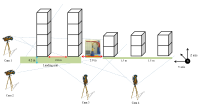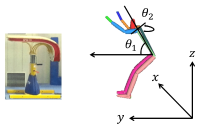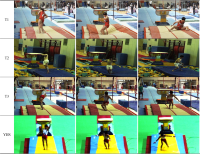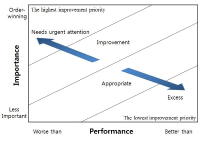PURPOSE This study aimed to investigate the effects of continuous exercise and the accumulation of short-duration exercise for 12 weeks on body composition, physical fitness, and lifestyle disease indices in overweight men in their 30s. METHODS Participants in the continuous exercise group (CE; n=13) performed a circuit exercise program of 30 min/session, 3 sessions/week for 12 weeks. Participants in the accumulation of short duration exercise group (ASE; n=12) performed the same exercise time of 30 min per day, divided into three sessions of 10 min. Body composition, physical fitness, and lifestyle disease indices were measured pre- and post-test and were compared by utilizing a repeated two-way ANOVA. RESULTS 1) Regarding body composition, body weight, body mass index, skeletal muscle mass, waist circumference, and fat mass decreased significantly, while hip circumference increased significantly in the CE group. Waist circumference and skeletal muscle mass decreased significantly, while hip circumference increased significantly in the ASE group. 2) Regarding physical fitness, right grip strength, sit and reach, sit up, and maximal oxygen uptake increased significantly in both groups. 3) Regarding hypertension indices, there were no significant differences in both groups, but they showed a tendency to improve. 4) Regarding hyperlipidemia indices, triglycerides (TG) decreased significantly in both groups, and total cholesterol (TC) decreased significantly in the CE group. 5) Regarding diabetes indices, there were no significant differences in both groups, but a tendency to improve was noticed. 6) Regarding arteriosclerosis indices: TG/high density lipoprotein-cholesterol ratio decreased significantly in both groups, and the TC/high density lipoprotein-cholesterol ratio decreased significantly in the CE group. CONCLUSIONS We concluded that both the accumulation of short duration exercise and continuous exercise can be effective in improving body composition, physical fitness, and lifestyle disease in overweight men.
PURPOSE The purpose of this study was to investigate the effects of 8-week aerobic exercise and polyphenol intake on body composition, cardiovascular response, vascular endothelial function, and physical fitness at rest and during exercise in prehypertensive men. METHODS The study included twenty-eight males in their 20-30 years of age with prehypertension. Participants in the aerobic exercise + polyphenol intake group (EX + PP; n = 14) performed aerobic exercise three sessions/week, 30 min/session, at 65% of the heart rate reserve, and consumed polyphenol (grape seed extract 300 mg) for 8 weeks. Participants in the aerobic exercise + placebo intake group (EX + PL; n = 14) performed the same aerobic exercise; however, they consumed placebo instead of polyphenol. All independent variables were measured at pre-test and post-test, and the data were analyzed. RESULTS The main results of the study were as follows: 1) SBP and MAP at rest decreased significantly in EX + PP, while MAP decreased significantly in EX + PL group. 2) In the EX + PP group, CO increased significantly, whereas DBP, MAP, and TPR decreased significantly during the hand grip exercise. In contrast, CO decreased significantly, while DBP and TPR increased significantly in the EX + PL group during the hand grip exercise. 3) Regarding vascular endothelial function, % FMD increased significantly in EX + PP group. 4) Sit-up increased significantly in both EX + PP and EX + PL groups; however, sit-and-reach in EX + PP group was significantly higher than that in EX + PL group at post-test. CONCLUSIONS The findings of this study showed that the 8-week aerobic exercise would have positive effects on body composition, cardiovascular response, and physical fitness at rest and during exercise in hypertensive men. Additionally, polyphenol intake would contribute more towards reduction of blood pressure at rest and during exercise and improvement of vascular endothelial function.
PURPOSE This study aimed to apply a team-building program for preparing the national archery team for competition in the Olympics. METHODS To achieve the purpose of this study, six national archers (three men and three women) were included. The team-building program was applied for a total 6 sessions (one session per week). Group cohesion and efficacy were measured three times before, after, and at a later application of the program. The collected data were analyzed with the Friedman and Wilcoxon signed-rank tests, which are nonparametric statistical techniques for data analysis. In addition, an in-depth interview for qualitative data was conducted for each archer to explore the effects and changes resulting from participation in the program. RESULTS The results of the study are as follows: first, the levels of team cohesion and efficacy in the national archery team increased after the implementation of the program compared to those in the pre-implementation state. Furthermore, high levels of team cohesion and efficacy were maintained at the follow-up measurement. Second, the archers recognized that closeness and faith in one another increased more between team members. Furthermore, there were positive changes in team communication, atmosphere, cohesion, and efficacy during team matches. CONCLUSIONS The team-building program applied in this study was found to have a positive effect on various factors related to team cohesion, such as team communication and team atmosphere. Therefore, future studies should consider developing a team-building program that can contribute to improving team sport performance for different sports and the effects of the program should be examined using various methods.

Purpose This study aims to investigate the experience of service yips in badminton players in depth through using grounded theory method. Methods We collected data from in-depth interviews with 14 participants in total, consisting of badminton players who experienced service yips, their doubles partners and coaches. The collected raw data were analyzed base on derive transcription, coding and paradigm models through grounded theory method. Results First, as a result, 59 concepts, 31 subcategories and 15 categories in regard to badminton service yips were deduced from open coding. Second, in axial coding, it was structured in a paradigm model by categories such as service yips, service mistakes, service proficiency, service anxiety, the imprinting experiences, the importance competition, the pressure of achievement, service practice, psychological control, tactical handling, support from partners, leaders’ coaching, advice from experienced ones, overcoming yips and persistent yips. Third, selective coding resulted in ‘Badminton service yips’ as the core category of this study. ‘Badminton service yips’ is a chronic performance impairment associated with badminton players making severe errors in swing motion on a service not intended by them that it is due to physiological or psychological symptoms such as hand tremors, overall body stiffness, arms stiffness, overstress, overanxiety, and concern over service mistakes. Conclusions We expect our study can be a theoretical foundation for understanding and explanation of ‘Badminton service yips’ and a useful reference for badminton players suffering from psychological difficulties caused by their service yips. The findings in this study should be considered for the development of potential strategies for overcoming the badminton service yips.

Purpose The purpose of this study is to identify the consistency and correlation of referee evaluation according to the judging characteristics in the preliminary and semi-final of the Latin event of dance sports, thereby deriving the problem of referee reliability and suggesting alternatives for improvement. Methods The method of study is Based on the performance data of 54 amateur Latin dances match organized by the Korea Dance Sports Federation for a total of three years 11,850(preliminary rounds & semi-final). Based on the Kappa statistics and the degree of agreement(pa), the difference in the group of examination characteristics was derived and the correlation between the five Latin events was analyzed. Results As a result of through this study, the consistency of the dance sports referee and the characteristics of the judging in the event were confirmed, and the number of judges tended to be higher when the number of judges was seven, the more the number of subjects was, and the highest level of agreement was more than 70 percent of the judges. In addition, the higher the concordance of each of the five detailed items, the higher the correlation tendency. Conclusion Differences in visual aspects between dance sports judges and the difference in the judges' ratings due to the revision of the rules, the decrease in the number of competitors participating in the competition, the number of people to be eliminated in each round, and the proportion of judges with experience in the competition are different, and these differences affect the judges and show up in the scores. The Latin dance sports events based on objectivity and reliability to improve the correct standards of judges to find the same raters, work will be required and an assessment element. With a systematic way in and to carry out the review curriculum and educational development is considered necessary.
The purpose of this study was to conduct an in-depth exploration of Korean national badminton players’ psychological momentum strategies. Data were collected using an open-ended questionnaire and group interviews of 66 badminton players, including 40 members of the 2018 Korean national badminton team and 22 college and semi-pro badminton players who each had badminton careers of 10 or more years and were registered in the Badminton Korea Association. The data were analyzed using inductive content analysis and the deductive process based on the inductively categorized results. The results are as follows. First, regarding strategies for maintaining positive momentum, 188 raw data were collected and classified into three category (keeping pace, dominating the play, and psychological facilitation) and 10 sub-category (including speedy resumption of the game, attacking weak points, and fighting shout). The results suggest that badminton players maintain positive momentum by using strategies to control the speed and tempo of the game at their preferred pace, implement special techniques, exploit their opponent’s weaknesses, and cheer or talk amongst themselves to motivate each other and communicate with their partners and coaches. Second, regarding strategies for overcoming negative momentum, 293 raw data points were collected and classified into three category (time outs, psychological reminders, and changes in plays) and 11 sub-category (including delaying the game, seeking social support, and play change). The data demonstrate that badminton players overcome negative momentum using strategies to intentionally delay the game and exchange equipment, focus on performance cues, and interact with their coaches and partners to change plays and prevent errors. It is hoped that these study findings will inform efforts to provide psychological support that is effective in increasing the odds of winning for the national badminton players in the Asian Games and the Olympic.
Purpose This study was conducted to analyze the differences of physical characteristics focused on the physique, strength, and power for cycling national athletes (Sprint cyclists and Road race cyclists). Methods We measured various factors (e.g., height, weight, body fat ratio, thigh circumference, waist circumference, anaerobic power, isokinetic muscular strength, muscle power, squat jump by 1RM intensity, and so on) for a total 11 male cycling national athletes (5 Sprint cyclists and 6 Road race cyclists). Results First, the body composition showed the significant differences only in weight (p=0.31) and BMI (p=.001) for Sprint cyclists. Second, the values of the anaerobic power for the Sprint cyclists were significantly higher than those for the Road race cyclists only at peak power (p=0.28), whereas there was no significant difference in average power, isokinetic muscular strength, and muscle power between the two groups. Third, the isokinetic trunk flexion muscle (p = .016) for the Sprint cyclists were significantly higher than those for the Road race cyclists. Fourth, the significant difference in Time to Peak Torque was not found between two groups. Fifth, the values for the Sprint cyclists showed the significant difference in all 5 intensity groups (0%, 30%, 50%, 60%, and 80%) (p=.001) of the squat jump. Also, there was a statistically significant difference only in 0% velocity between the two groups, except for exercise intensity. Conclusions From the various measures between two groups, the Sprint cyclists relatively showed the high weight, BMI (muscle mass), and maximum power. Additionally, the isokinetic trunk flexion muscle and the squat jump were higher in the Sprint cyclists than the Road race cyclists. These data may be used as basic data to improve the physical fitness factors related to the athletic performance of the athletes by reflecting them in the effective training plan and evaluation of the athletes.

Purpose This study was designed to develop a team building program that helps freshmen student-athletes to adapt to college life and enhance team function and process and to examine the effects of this program. It could provide basic information of a team building program that effectively accelerates team function in the college team sports domain. Methods The program was developed through this process. First, an open-ended questionnaire was utilized to discover the needs of the program. Second, the results of needs of the program and important factors of team-building program were taken into consideration. Third, expert meetings were conducted. Consequently, the program consisted of three stages of total 10 sessions which was 90 min long. The questionnaires(Group Cohesion Questionnaire and Coach-Athlete Relationship Questionnaire), experience report, and program evaluation form were used as measures to identify the effects of the developed program. SPSS version 24.0 and inductive analysis were used to analyze the data. Results The results of this study are as follows. First, there was no statistically significant influence between developed program and the level of group cohesion. In contrast, the level of coach-athlete interaction was significantly increased. Second, the analysis of experience report revealed that this program reduced interpersonal conflict between team members and formed positive interpersonal relationship by mind of respect and consideration. Conclusion In conclusion, the hierarchical culture was strongly formed and team member suffered from the dual role of athlete and student in Korean college team sports. Thus, these should be resolved in order to enhance team function and process. As a results, this process could increase team performance as well as offer psychological stability to college student-athletes.


Purpose The purpose of the study was to perform a comparative analysis of the YANG Hak Seon technique carried out by "K" athlete with the kinematical data of "Y" athlete and propose a method to improve the YANG Hak Seon technique of "K" athlete. Method The subject recruited for the study was a male athlete from Korean national team (Age: 21, height: 1.65 m, body weight: 59.6 kg, and career: 11 years). Four high - speed cameras were used to analyze the 3D motion of the YANG Hak Seon technique performed by "K" athlete. The variables selected for analysis were the velocity of COM, displacement of COM, the rotational & torsional angle of the trunk and rotational & torsional angular velocity of the trunk. The results obtained were compared to the preexisting data of the "Y" athlete (data set from the published research). Results Firstly, the horizontal displacement of the YANG Hak Seon technique of the "K" athlete was observed to be shorter along with lower vertical displacement during landing compared to “Y” athlete. In addition, the overall horizontal velocity was low and vertical velocity was not generated which rises during the BC (board contact) phase. Although the rotational angular velocity of the trunk was lower during the BC, HC (horse contact) phase and LD (landing) phase, torsional angular velocity was higher during the LD. Conclusion In order to improve the completeness of the YANG Hak Seon technique of the K player, it is necessary to enter with a fast and low posture on the footplate during the initial phase. In the BC phase, it is essential to raise the COM simultaneously while landing on the footplate and increase the rotational angular velocity of the trunk.




Purpose The purpose of this study was to verify the importance and satisfaction of service quality of visitors to screen baseball using the Importance-Performance Analysis. Methods Selected visitors who participated in screen baseball using convenience sampling of non-probability sample method from January 26 to May 27, 2017, and conducted a questionnaire survey to a total of 213 data were used in this study except 17 data which were untrustworthy responses or non-responses. SPSS 21.0 statistical program were used to exploratory factor analysis, reliability analysis, frequency analysis and IPA. Results The results were as follows. first of all,Ⅰquadrant derives 7 items including modernized facilities and equipments. Next, Ⅱ quadrant, there are 5 credibility of the program and continuous service provision. Also, in the quadrant Ⅲ, the service promised to the customer and the interest and effort of the staff in case of trouble were confirmed.. In the quadrant IV, four items were analyzed such as the interest in the members and the matching of the members' use time. In the analysis of Slack's(1994) diagonal model, twelve kinds of improvements such as costumes, appearance, internal facilities and services promised to customers were derived. In addition, there are 5 appropriately provided properties such as modern facilities and equipment, and facilities suitable for enjoying baseball. Finally, in the attributes that are provided in excess, four attributes are indicated, attention to members and matching of members' use time. Conclusion Based on the results of this study, it is meaningful to be a marketing and management practice data for operating the screen baseball.



